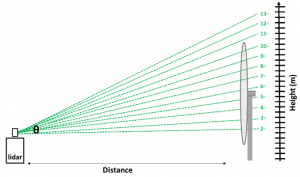 To address the need for offshore wind measurements aloft at turbine‐rotor heights, lidar remote sensing technology is proving to be a reliable alternative from traditional met-towers. Doppler wind lidars provide high‐quality measurements of wind speed and direction, vertical velocity statistics, mixing layer heights and turbulent kinetic energy profiles from the surface up to several hundred meters above the air‐water interface. Such information is valuable to the wind energy community as it elucidates the structure and evolution of boundary layer processes at fine vertical, horizontal, and temporal resolutions. Nonetheless, it is also important to characterize uncertainty associated with Doppler lidar wind retrievals. In collaboration with the National Oceanic and Atmospheric Administration (NOAA) and the Department of Energy (DOE) Atmosphere-to-Electrons (A2E) program, the Doppler Lidar Uncertianty (DLU) branch of U-SPARC strives to understand the trade-offs of various Doppler lidar wind retrieval techniques and uses this information to further reduce site measurement, resource and wake effect related wind farm energy yield uncertainties. Recently, the DLU team participated in two NOAA and DOE field campaigns, Lidar Uncertainty Measurement Experiment (LUMEX) and EXperimental Measurement Campaign for Planetary Boundary Layer Instrument Assessment (XPIA) in Boulder, Colorado. Campaign goals were the following:
To address the need for offshore wind measurements aloft at turbine‐rotor heights, lidar remote sensing technology is proving to be a reliable alternative from traditional met-towers. Doppler wind lidars provide high‐quality measurements of wind speed and direction, vertical velocity statistics, mixing layer heights and turbulent kinetic energy profiles from the surface up to several hundred meters above the air‐water interface. Such information is valuable to the wind energy community as it elucidates the structure and evolution of boundary layer processes at fine vertical, horizontal, and temporal resolutions. Nonetheless, it is also important to characterize uncertainty associated with Doppler lidar wind retrievals. In collaboration with the National Oceanic and Atmospheric Administration (NOAA) and the Department of Energy (DOE) Atmosphere-to-Electrons (A2E) program, the Doppler Lidar Uncertianty (DLU) branch of U-SPARC strives to understand the trade-offs of various Doppler lidar wind retrieval techniques and uses this information to further reduce site measurement, resource and wake effect related wind farm energy yield uncertainties. Recently, the DLU team participated in two NOAA and DOE field campaigns, Lidar Uncertainty Measurement Experiment (LUMEX) and EXperimental Measurement Campaign for Planetary Boundary Layer Instrument Assessment (XPIA) in Boulder, Colorado. Campaign goals were the following:
1) characterize sampling error for vertical velocity statistic / scanning spatial representativeness
2) investigate the sensitivity of different Doppler lidar systems under various atmospheric conditions,
3) inter-compare various single and multiple Doppler retrieval techniques
4) validate turbulence and wind retrieval techniques.
Collectively, results demonstrate scanning Doppler wind lidar technology is a viable economic alternative for characterizing wind conditions important for wind turbine performance; albeit more measurements, research and testing offshore is required.
An overview of the U-SPARC DLU efforts can be found here.